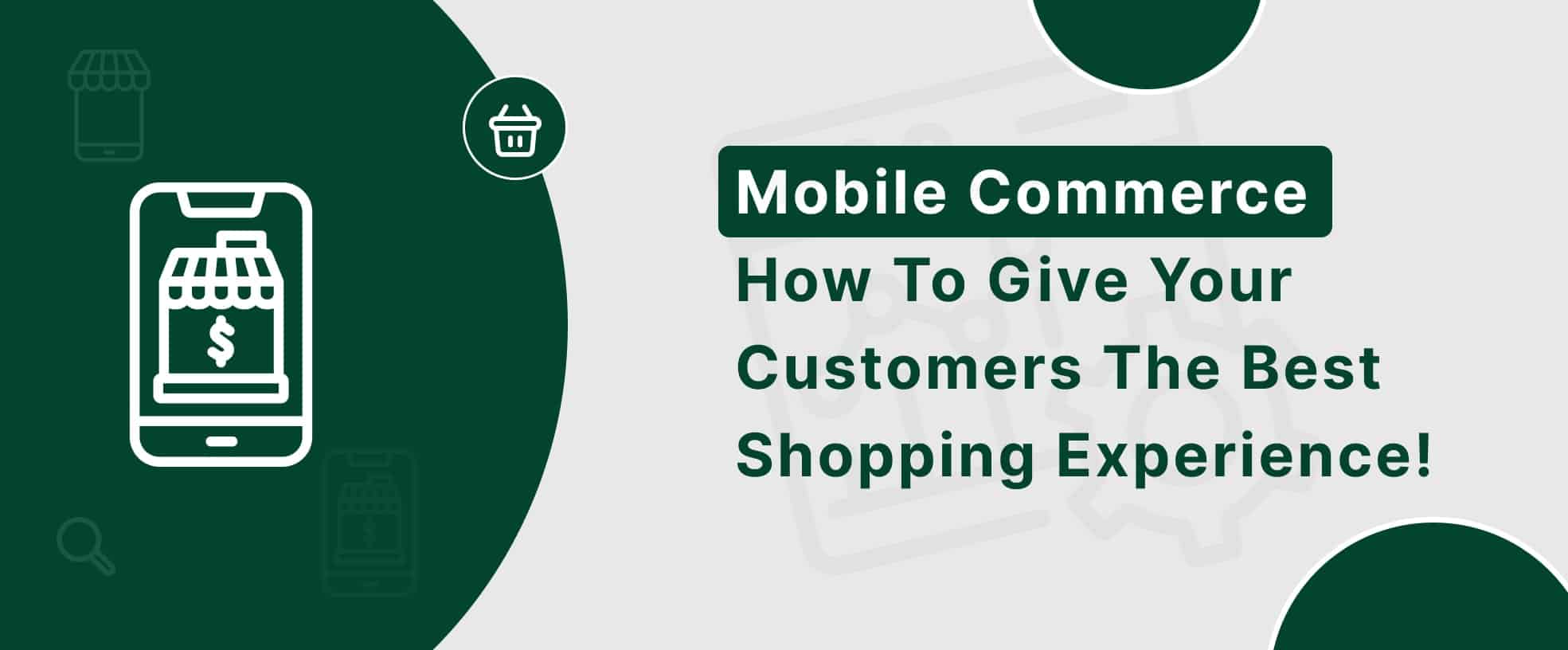Mobile Commerce – How to Give Your Customers The Best Shopping Experience!

When someone says M-commerce (Mobile Commerce), chances of misconceptions remain there. Today, most websites fall into the mobile-friendly ecommerce website category. However, when creating an ecommerce website and app development for the same ecommerce business, we are going to deal with M-Commerce.
Therefore, today, we will discuss ecommerce mobile application development and mobile-friendly ecommerce website design simultaneously in the current post. The primary aim of the post is to provide knowledge about how to build a seamless shopping experience in mobile commerce development, where our team of ecommerce developers at iCommuneTech has commendable expertise in ecommerce website development and mobile app development.
For the sake of clarity, let me say that a mobile-friendly ecommerce website allows transactions from any device, including desktop, laptop, smartphone, tablet, etc. In the case of M-Commerce, transactions happen only on mobile devices. This means that M-commerce is a subset of the broader term e-commerce.
How to Design a Mobile-Friendly M-commerce Website?
In M-Commerce development, our focus remains on mobile-friendly design, which gives the best mobile commerce UX and mobile shopping experience at the core.
Go to Responsive Web Design:
When you are going to design a mobile-friendly ecommerce website, you must follow all mobile commerce design principles, and a responsive web design approach is the way to do so. So, responsive web design is the only way to deliver exceptional mobile commerce UX (user experience) to your ecommerce website. Based on your choice of the ecommerce platform, you can use a free or paid responsive theme.
Make Text Readable:
The readability of textual content is an issue on different mobile devices. Use mobile-friendly fonts and sizes, optimize them, and test them.
Make Navigation Mobile-friendly:
Mobiles have a unique navigation scheme. So, try to adapt it and make the navigation scheme as simple as possible.
Optimize Images, Videos, and Multimedia Content:
Compress and resize images according to responsive design principles to display appropriately on mobile devices, even if it should support retina eye view. Apply the same to other multimedia content such as videos, audio, animations, etc
Optimize CTA:
Call-to-action buttons and texts must be mobile-friendly so users can use their thumbs and fingers to tap them without any distractions.
Create Mobile Commerce UX:
To create mobile commerce UX, you must optimize product pages and category pages, use voice search, intelligent search, and take an omnichannel approach to deliver a mobile shopping experience.
We have some excellent tips on ecommerce mobile website development. However, in the mobile era, the development of only mobile-friendly e-commerce websites is not enough. We must go for both mobile-friendly e-commerce website development and e-commerce mobile app development. So, let’s look at mobile commerce app development.
Get the best ecommerce website and application for your business:Contact Us now!
Mobile Commerce Application Development:
Mobile Commerce app development begins with the mobile app UI design. The mobile app UI design differs from mobile-friendly ecommerce website design in many aspects, such as:
With these insights, let’s see the primary elements of mobile commerce to build a seamless shopping experience.
Select Right UI Elements:
Shoppers’ interactions are of paramount importance in delivering an exceptional shopping experience. Therefore, carefully select the UI elements to give advanced functionality and actions. Our mobile commerce design team prefers the following smart UI elements.
Similarly, select CTA UI elements carefully to differentiate elements that are intended for different actions from each other. Use different shapes and colors.
Simplify Onboarding on Your Mobile Commerce App:
New users need some training before starting to use your ecommerce mobile application. Therefore, design onboarding tasks smartly and provide them with complete guidance without making the process complex. Never try to ask too much information at once from new users. Educate them about the benefits they will receive by providing their information and ensuring the security of their data with you.
Give guest checkout options for hurried users and tempt shoppers, giving various incentives when they are ready to register an account with your mobile commerce application.
Provide Advanced Search:
Many experienced ecommerce shoppers bypass traditional navigation schemes. They use a quick search facility instead. So, incorporate an advanced on-site search engine in your ecommerce mobile app. You can use the following search features:
If you have a sizable online storefront, filtered search facilities make the shopping experience a breeze. You can use filters for prices, product categories, and various product attributes.
If you can add voice search, it will make life easy for mobile commerce shoppers. Alternatively, image search also helps many shoppers to find their choice of products they have seen in their locality or on other media.

Develop Interactive Mobile Ecommerce:
Videos and animations are primary elements to enhance user engagement. If your product permits, you can use AR/VR technologies to make your mobile commerce app highly interactive and converting. AR/VR technologies display many hidden aspects of your products in the virtual world that can give your shoppers a nearly real-life product experience and innovative ways to use them.
Give Omnichannel Support:
Modern shoppers have multiple ways to reach your ecommerce, including websites, mobile apps, social media networking sites, and brick-n-mortar stores. Develop omnichannel mobile commerce app, so that shoppers can come and buy your products or services using any mode, including online, offline, or hybrid. They must have a seamless shopping experience without any hurdles.
Offer Enough Payment Options:
Modern shoppers use various payment methods and have their unique payment gateway preferences, particularly regional ones. Let them use cash, cards, digital wallets, buy now, pay later, etc. options. Try to integrate globally popular payment gateways such as PayPal, Strip, etc., along with many regional payment gateways depending on the geographies of your target audience. Multilingual and multi currency support prove vital to global and regional audiences.
Get The Best Payment Gateway Integration Services Today!Develop Quick Checkout Process in Your Mobile Commerce App:
Provide Order to Delivery Tracking Facility:
Integrate order and shipping tracking third-party applications or platform-specific extensions. Order tracking relieves stress for shoppers and brings transparency into ecommerce.
The following tracking tools are helpful for ecommerce mobile application development and ecommerce mobile website development.
1. ShipStation- To find the best rate among multiple shipping carriers.
2. AfterShip – It’s a package tracking app
3. Trackr Order Tracking – An order tracking app.
4. Route – A popular order tracking app
5. Rush – A package tracking automation tool.
6. WareIQ – Provides order tracking, order management, and inventory management.
7. YITHWoocCommerce app – It’s a plugin that inserts tracking data into orders.
Provision for Wishlist:
As its name suggests, a Wishlist is a list of ecommerce products that shoppers are interested in buying in the near future. This saved product list has several advantages, such as:
1. Wishlist enhances CX (customer experience) by organizing shopping.
2. It cuts the cart abandonment rate.
3. It enhances customer engagement.
4. It drives more sales
Our ecommerce development team at iCommuneTech suggests some key functionality elements to look for in a wishlist design.
Ecommerce Conversion Rate Optimization – Top 5 Tips and Tricks!
Go for Abandoned Cart Follow-up:
For an e-commerce company, abandoning a cart is an apparent loss. There are several reasons behind cart abandonment. Our ecommerce designers and programmers suggest the following steps to minimize it.
Key Takeaways for Mobile Commerce Development:
| We have concluded the following key takeaways for our mobile commerce development guide: | ||
|---|---|---|
| Mobile-first design | Fast loading | Simple checkout |
| Mobile optimized content | Personalization | Omnichannel approach |
| Multiple payment methods | Chatbot, AR/VR, AI, IoT technologies integration | Social commerce integration |
Consider these features and functionality to achieve the desired success in your mobile commerce adventure.
If you are looking to build an e-commerce website or application for your business, thenwait no more! The Ecommerce development team for mobile apps and websites at iCommuneTech awaits your response to offer you a free quote and free consulting service.

